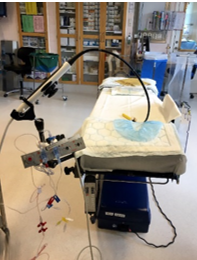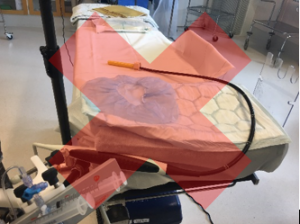Improving Safety and Ergonomics in the Operating Room with the TEE Probe Holder

As medical professionals, we constantly evaluate situations, identify problems and take action to ensure the best results. From frontline patient care to environmental safety within the medical center, we strive to avoid unnecessary complications. Understanding the work environment and controlling variables is key to improving workflow and overall outcomes in our daily work.
Physicians and clinicians who see safety issues or potential risks first-hand are key to developing solutions to address those problems. Cardiac Anesthesiologist, Johan Sellgren, MD, PhD of Sahlgrenska University Hospital in Göteborg, Sweden, developed a solution to
a common problem he regularly experienced in the operating room.

Dr. Sellgren performs TEE monitoring during anesthesia for cardiac surgery and is the inventor of CIVCO's TEE Transducer Holder. "There is an obvious need to 'park' the TEE probe maneuver handle when you are not actively monitoring by holding the handle. This is very useful, especially when monitoring myocardial contractility in the transgastric short-axis view, such as when you are weaning the patient from cardiopulmonary bypass."
Utilizing a positioning system in the operating room or theater has benefits including providing a secure and convenient place for the transducer, improving physician handling and ergonomics, increasing patient safety, and protecting the capital investment of the TEE transducer during intraoperative cardiac monitoring.

Top 4 Clinical Benefits of the TEE Transducer Holder:
-
- Providing a secure and convenient parking place for the transducer
The pole of the TEE transducer holder may also be used for mounting pressure gauges. When the probe is in the holder, it allows for small active movements during monitoring without the need to remove and manipulate the transducer. - Improving physician handling and ergonomics
The probe and pressure monitors are in a stable location, attached to the surgical bed in an ideal area for monitoring which can improve ergonomics within the confined anesthesia workspace. - Promoting improved patient safety
Special care is taken during an intraoperative TEE procedure. The transducer is in position and used for longer durations. Thinning the blood using anticoagulation medication and hypothermia during cardiac surgery can leave the mucosa vulnerable to pressure necrosis and ischemia.(1) In the words of Dr. Sellgren, "Using the holder helps to protect the patient's mouth from TEE probe stretching since the system is very adjustable in both height and angle." - Protecting your capital probe investment
The TEE holder has the advantage of protecting the probe from damage. Delicate transducer design generates more service calls than ultrasound systems and service and maintenance contracts are costly to acquire.2 The replacement costs for a TOE/TEE probe can be more than $50,000.(2)
- Providing a secure and convenient parking place for the transducer
Current alternatives being used to store TEE probes in the peri-operative environment:
The following are areas where there are opportunities for improvements in storage conditions during the procedure by using the TEE holder:
 Storage of the
transducer under the patient's head
Storage of the
transducer under the patient's head
- The probe can easily fall onto the ground, resulting in damage. If it is in place for passive monitoring of cardiac function, there is an interruption in imaging, and repositioning is required.
- Hang transducer from a nearby IV pole
- Once again, it can easily fall and partially pull out of the patient's esophagus, potentially causing injury to the patient and requiring repositioning.
- Use the ultrasound system transducer holder
- This practice can put a strain on the patient's mouth. The probe can be easily bumped and become loose from the holder. You position the ultrasound system for usability and monitor visibility, not to ensure the probe holder is in the correct location to yield the safest environment to hold the TEE probe during monitoring of the patient. Let the system do its job and let the TEE Holder do its job.
CIVCO's TEE Transducer Holder is the ideal choice to position and protect your probe investment while creating an ergonomic environment during cardiac monitoring in the operating suite.
See the clinical uses and benefits of the TEE Probe Holder, as demonstrated by Dr. Sellgren
References
- Mathur SK, Singh P. "Transesophageal Echocardiography Related Complications." Indian Journal of Anaesthesia. 2009;53(5):567-574.
- Reich, D. and Fischer G., "Perioperative Transesophageal Echocardiography." Elsevier Saunders. 2014: Philadelphia, PA.






